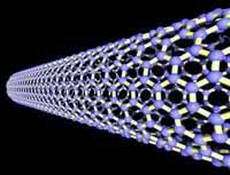Researchers Achieve First Electrowetting of Carbon Nanotubes

If you can imagine the straw in your soda can being a million times smaller and made of carbon, you pretty much have a mental picture of a carbon nanotube. Scientists have been making them at will for years, but have never gotten the nanotubes to suck up liquid metal to form tiny wires. In fact, conventional wisdom and hundreds of refereed papers say that such is not even possible.
Now, with the aid of an 1875 study of mercury's electrical properties, researchers from the California Institute of Technology have succeeded in forcing liquid mercury into carbon nanotubes. Their technique could have important applications, including nanolithography, the production of nanowires with unique quantum properties, nano-sized plumbing for the transport of extremely small fluid quantities, and electronic circuitry many times smaller than the smallest in existence today.
Reporting in the December 2 issue of the journal Science, Caltech assistant professor of chemistry Patrick Collier and associate professor of chemical engineering Konstantinos Giapis describe their success in electrowetting carbon nanotubes. By "electrowetting" they mean that the voltage applied to a nanotube immersed in mercury causes the liquid metal to rise into the nanotube by capillary action and cling to the surface of its inner wall.
Besides its potential for fundamental research and commercial applications, Giapis says that the result is an opportunity to set the record straight. "We have found that when measuring the properties of carbon nanotubes in contact with liquid metals, researchers need to take into account that the application of a voltage can result in electrically activated wetting of the nanotube.
"Ever since carbon nanotubes were discovered in 1991, people have envisioned using them as molds to make nanowires or as nanochannels for flowing liquids. The hope was to have the nanotubes act like molecular straws," says Giapis.
However, researchers never got liquid metal to flow into the straws, and eventually dismissed the possibility that metal could even do so because of surface tension. Mercury was considered totally unpromising because, as anyone knows who has played with liquid mercury in chemistry class, a glob will roll around a desktop without wetting anything it touches.
"The consensus was that the surface tension of metals was just too high to wet the walls of the nanotubes," adds Collier, the co-lead author of the paper. This is not to say that researchers have never been able to force anything into a nanotube: in fact, they have, albeit by using more complex and less controllable ways that have always led to the formation of discontinuous wires.
Collier and Giapis enter the picture because they had been experimenting with coating nanotubes with an insulator in order to create tiny probes for future medical and industrial applications. In attaching nanotubes to gold-coated atomic force microscope tips to form nanoprobes, they discovered that the setup provided a novel way of making liquid mercury rise in the tubes by capillary action.
Casting far beyond the nanotube research papers of the last decade, the researchers found an 1875 study by Nobel Prize-winning physicist Gabriel Lippmann that described in detail how the surface tension of mercury is altered by the application of an electrical potential. Lippmann's 1875 paper provided the starting point for Collier and Giapis to begin their electrowetting experiments.
After mercury entered the nanotubes with the application of a voltage, the researchers further discovered that the mercury rapidly escaped from the nanotubes immediately after the voltage was turned off. "This effect made it very difficult to provide hard proof that electrowetting occurred," Collier said. In the end, persistence and hard work paid off as the results in the Science paper demonstrate.
Giapis and Collier think that they will be able to drive various other metals into the nanotubes by employing the process at higher temperature. They hope to be able to freeze the metal nanowires in the nanotubes so that they remain intact when the voltage is turned off.
"We can pump mercury at this point, but it's possible that you could also pump nonmetallic liquids," Giapis says. "So we now have a way of pumping fluids controllably that could lead to nanofluidic devices. We envision making nano-inkjet printers that will use metal ink to print text and circuitry with nanometer precision. These devices could be scaled up to operate in a massively parallel manner. "
The paper is titled "Electrowetting in Carbon Nanotubes." In addition to Collier and Giapis, the other authors are Jinyu Chen, a postdoctoral scholar in chemistry, and Aleksandr Kutana, a postdoctoral scholar in chemical engineering.
Source: Caltech















